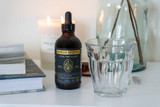Increasing Testosterone Response With Cell Receptor Health
Evidence-Based Strategies to Increase Androgen Hormone Sensitivity
Testosterone levels—including both free and total testosterone—dominate discussions of health, performance, and wellness. While these levels are undeniably important, as are levels of other male and female sex hormones, equally important is the sensitivity of androgen receptors.
What Are Androgen Receptors?
Androgen receptors (ARs) are proteins located on cell membranes that bind to androgens such as testosterone and dihydrotestosterone (DHT), which circulate in the blood. Think of ARs as the lock on your front door and testosterone as the key. When activated—when testosterone is present—these receptors “unlock,” allowing testosterone into the cell, where it makes its way to the nucleus. There, testosterone and other androgenic hormones regulate genes involved not only in muscle growth, energy metabolism, and reproductive health, but also in a wide range of other essential bodily functions.
Androgen receptor sensitivity refers to how well the key (the androgenic hormone) fits the lock (the receptor), as well as how many receptors are available. The more sensitive—and the more numerous—the receptors, the more pronounced the effects of androgenic hormones.
In this article, we’ll take an in-depth look at androgen receptor sensitivity and explore scientific, evidence-based strategies to enhance it—effectively magnifying the benefits of testosterone. From exercise and nutritional recommendations to stress management and reducing exposure to environmental toxins, we’ll focus on practical, actionable ways to promote androgen receptor sensitivity in support of better health, performance, wellness, and longevity.
The Critical Role of Androgen Receptor Sensitivity
Before moving forward—and at the risk of belaboring the lock-and-key analogy—it’s important to emphasize why androgen receptor sensitivity matters when discussing androgen (testosterone) hormone levels. How sensitive a cell is to the presence of testosterone is just as important as the blood levels of free, bound, and total testosterone.
If someone glues the lock on your front door shut, it matters very little how many spare keys you have—the lock itself is unusable. In the same way, high blood testosterone levels mean little if the androgen receptors are essentially closed off.
The reverse is also true: the more sensitive—and the more numerous—the androgen receptors are, the more efficiently testosterone can enter the cell and unlock its potential.
The Functions of Androgen Receptors
Androgen receptor sensitivity directly influences how effectively the body responds to circulating testosterone. Androgen receptors play a key role in many essential functions in both women and men, including muscle growth, energy levels, mental health, and reproductive health. When circulating androgenic hormones bind to androgen receptors, they can enter the cell and initiate complex genetic and cellular processes that support a wide range of vital functions.
Even when testosterone levels are high, low androgen receptor sensitivity can hinder the body’s ability to fully utilize the hormone, affecting vitality, performance, and overall health.

Supporting Androgen Receptor Sensitivity
Just as our daily actions directly affect androgenic hormone production, they also influence androgen receptor sensitivity. Specific lifestyle modifications can significantly improve how the body responds to testosterone, DHT, and other androgenic hormones. From exercise and nutrition to stress management, evidence-based strategies are available to enhance androgen receptor sensitivity. The greater the number—and the greater the sensitivity—of androgen receptors, the more effectively the body can utilize circulating testosterone.
Below, we’ll outline these strategies and highlight the research that supports them.
Proandrogenic Weight and Strength—Resistance—Training
Building Strength and Enhancing Androgen Receptor Function
Resistance training—lifting weights—is one of the most reliable ways to support both androgen receptor sensitivity and androgenic hormone production. Ample research, including work by Vingren et al. (2010), demonstrates that strength training increases androgen receptor density, thereby amplifying the effects of testosterone. Compound movements such as squats, deadlifts, overhead presses, and bench presses offer a wide range of benefits—not only building strength and muscle mass but also increasing hormone production and sensitivity, including growth hormone.
Few other actions are as well documented for promoting healthy aging and longevity as regular resistance training.
Takeaway – Develop a consistent weight and strength training routine that includes compound, multi-joint exercises to support strength, mobility, androgen receptor sensitivity, and long-term health. See Proandrogenic Weight and Strength Training.
An Eye on Nutrition and Diet
Essential Nutrients with Essential Functions for Androgen Hormone Sensitivity
Let food be thy medicine—and let food support a healthy endocrine system. Micronutrients such as zinc and magnesium play vital roles in hormone health, influencing both hormone production and receptor sensitivity.
Zinc, a trace mineral, is essential for testosterone synthesis and supports androgen receptor function. It's found in foods like red meat, shellfish, and legumes. Research by Prasad (2013) highlights how zinc deficiency can reduce androgen receptor sensitivity and lower testosterone’s effectiveness in the body.
Magnesium also plays a key role in endocrine function, contributing to energy production, muscle contraction and relaxation, and hormonal balance. A study by Cinar et al. (2011) found that magnesium supplementation increased free testosterone levels in athletes, suggesting a role in supporting both testosterone status and potentially receptor sensitivity.
Whole Food Sources of Zinc and Magnesium
Zinc-rich foods include pumpkin seeds, lentils, chickpeas, quinoa, and tofu. Magnesium can be found in spinach, almonds, chia seeds, avocados, and whole grains.
Additionally, RAW Pine Pollen™ offers a natural source of phytoandrogens and bioavailable nutrients like zinc and magnesium—nutrients that may support androgen receptor function and testosterone production.* While more research is needed to confirm its exact mechanisms, Pine Pollen presents a promising dietary intervention for promoting androgenic hormone health.
Takeaway – Ensure adequate intake of zinc and magnesium—whether through whole foods, supplements, or natural sources like RAW Pine Pollen™—to support optimal androgen receptor function and hormone balance.
Is Cortisol The Anti-Androgenic Hormone?
Managing Stress and Cortisol Levels to Increase Androgen Hormone Sensitivity
It’s no news to anyone how far-reaching—and how profoundly detrimental—the effects of stress can be on nearly every aspect of health. And while stress undermines many physiological systems, particularly relevant to this discussion is how stress—and specifically the stress hormone cortisol—influences androgen receptor sensitivity.
Cortisol, the body’s primary stress hormone, competes with testosterone, DHT, and other androgenic hormones at the androgen receptor. A study by Kraemer et al. (2020) found that elevated cortisol levels reduce androgen receptor sensitivity, highlighting the importance of effective stress management in maintaining a healthy endocrine system response.
Remember the analogy of being unable to unlock the front door because glue was in the lock? In this case, cortisol is that glue. Cortisol binds to the androgen receptor, blocking testosterone’s ability to “unlock” and enter the cell. Cortisol is an antagonist to androgenic hormones, interfering with their actions at the receptor level.
Chronic stress, therefore, not only compromises seemingly every aspect of health—it specifically disrupts the body’s anabolic processes, which are essential for both women and men.
Evidence-Based Strategies for Stress Reduction
Regular aerobic exercise, quality sleep, and mindfulness practices like meditation can all help reduce cortisol levels—an indicator of the body’s stress response. Additionally, nutritional interventions such as omega-3 fatty acids, dark chocolate, and green tea have shown benefits in supporting balanced cortisol levels.
Takeaway – Regular exercise, sufficient sleep, and mindfulness practices can help lower cortisol, promoting an optimal response to testosterone.
Adaptogenic and Tonic Herbs
Time-Tested and Scientifically Validated Support for Hormone Health
While the term adaptogen is relatively new, the concept and practice behind it are anything but. The earliest writings of Classical Chinese Medicine and Ayurveda—dating back not just decades or centuries, but literally millennia—document the use of herbs now classified as adaptogens to support health, vitality, and how the body responds to stress (increasing resilience) .
In Classical Chinese Medicine, these herbs were known as Shàng Pǐn (Superior Herbs), first documented in the Shén Nóng Běn Cǎo Jīng. In Ayurveda, they were called रसायण (Rasāyana)—formulas or substances believed to promote rejuvenation and longevity. Their use is documented in the Charaka Saṃhitā, written in the first millennium BCE.
Today, growing scientific research validates the efficacy of many of these traditional phytotherapeutics in improving numerous aspects of health—particularly immune function, stress resilience, sex hormone production, and hormone receptor sensitivity. Eurycoma longifolia Jack (Tongkat Ali) and Withania somnifera (Ashwagandha) have been shown to support androgen hormone production and enhance androgen receptor sensitivity.
Eurycoma longifolia Jack has been associated with increased testosterone levels and improved androgen receptor function (Henkel et al., 2014). Ashwagandha may enhance muscle strength and recovery, with potential benefits for receptor sensitivity (Wankhede et al., 2015).
RAW Pine Pollen™ provides additional phytoandrogenic, nutritional, and micronutrient support through essential vitamins, minerals, and amino acids that may promote androgen receptor sensitivity—complementing adaptogens like Tongkat Ali and Ashwagandha.
Takeaway: Incorporating adaptogens, along with phytoandrogen sources like RAW Pine Pollen™, offers natural support for improving endocrine and hormone health.
Cold Exposure for Health and Performance
Can Intentional Cold Exposure Increase Androgen Receptor Sensitivity?
Emerging research suggests that intentional cold exposure—such as cold showers, ice baths, or cryotherapy—may positively influence androgen receptor sensitivity. A study by Blondin et al. (2020) found that cold exposure increased androgen receptor expression in brown adipose tissue, a specialized fat involved in thermoregulation and energy metabolism.
Additionally, cold exposure may help lower cortisol levels, potentially reducing stress and improving overall hormonal balance—including the body’s responsiveness to androgenic hormones (Leppäluoto et al., 2008)
Takeaway: While cold exposure is not a cure-all—and the research is still evolving—practices like cold showers or cryotherapy may offer supportive benefits for hormonal health.
Environmental Toxins and Endocrine System Disruptors
Mimizing Exposure to Improve Endocrine System Health and Androgenic Hormone Sensitivity
Research—and evidence—on the widespread prevalence of endocrine system disruptors can be overwhelming and, to put it mildly, disheartening. But the reality is that for many people, limiting exposure to, and the harmful effects of, endocrine system disruptors is possible.
What are Endocrine System Disruptors?
Endocrine system disruptors, technically referred to as endocrine-disrupting chemicals (EDCs), are a class of compounds that interfere with hormone activity in the body—they disrupt the endocrine system and, by extension, all the physiological processes it regulates.
EDCs are defined by their ability to mimic, block, or alter the normal function of hormones, often by binding to hormone receptors, modifying hormone synthesis, or interfering with hormone metabolism. These chemicals can influence development, reproduction, metabolism, and even behavior.
They are commonly found in plastics (like BPA and phthalates), pesticides, flame retardants, personal care products, and household cleaners—making everyday exposure difficult to avoid without conscious effort. Yet, for many people, conscious effort is possible, and small changes can have large impacts.
Common Exposure Sources of Endocrine-Disrupting Chemicals
One prevalent source of EDC exposure is Bisphenol A (BPA), commonly found in consumer plastic products such as water bottles, food containers, and the linings of metal cans. Research indicates that BPA can interfere with endocrine function by binding to hormone receptors, including androgen receptors, potentially disrupting hormonal balance.
Additionally, many personal care products contain phthalates, chemicals used to increase the flexibility and durability of plastics. Phthalates are often present in items like shampoos, lotions, and fragrances, and have been associated with endocrine disruption, potentially affecting reproductive health.
Exposure to EDCs can also occur through the consumption of non-organic produce treated with certain pesticides known to have endocrine-disrupting properties. These chemicals can interfere with hormone function and may pose health risks upon ingestion.
Furthermore, household cleaning products can be another source of EDC exposure. Some cleaning agents contain chemicals that may disrupt endocrine function, leading to potential health concerns.
Takeaway – Being aware of common sources of EDCs—such as BPA in plastics, phthalates in personal care products, certain pesticides on produce, and chemicals in household cleaners—can empower us to make informed choices that reduce exposure and support hormonal health.
Taking Action to Create a Holistic Approach to Androgenic Hormone Health
As research evolves, it’s becoming increasingly evident that optimizing androgen receptor sensitivity is a key factor in how effectively the body can utilize testosterone and other androgens.

If we narrow our focus on male sex hormone health to specific levels of free, bound, and total testosterone, we risk losing the bigger picture. We lose sight of the complex interplay among sex hormones—including both androgenic and estrogenic hormones—stress hormones like cortisol, and the critical role of hormone receptor sensitivity. As research progresses, it’s becoming increasingly clear that optimizing androgen receptor sensitivity is essential to realizing the full benefits of testosterone and other androgens.
And when we narrow our focus too tightly, we also miss the broader context of how our overall lifestyle—from the cleaners we use at home to the people we spend time with—can shape, support, or hinder our health. It’s not just about numbers; it’s about the full ecosystem of our daily lives. Is how the actions we take learn toward or lean away from health.
This is not a call for perfection, nor is it a zero-sum, never-ending checklist of 10,000 things we must do each day to “be healthy.” In fact, I can’t think of a more unhealthy way to approach health than to constantly stress and strive for perfection—to pathologize every detail of how we live.
As I said above, and I’ll say again here: it’s about how we lean toward or lean away from health. Proandrogenic weight and strength training, realistic modifications to diet—such as including mineral-rich foods—reducing stress, and lowering (not eliminating) exposure to EDCs and other environmental toxins all represent ways we can lean toward health.
As the saying goes, perfect is the enemy of good—and too often, perfection is also the enemy of health.
References
Blondin, D. P., Nielsen, S., Kuipers, E. N., Severinsen, M. C., Jensen, V. H., Miard, S., Jespersen, N. Z., Kooijman, S., Boon, M. R., Fortin, M., Phoenix, S., Frisch, F., Guérin, B., Turcotte, É. E., Haman, F., Richard, D., Picard, F., Rensen, P. C. N., Scheele, C., & Carpentier, A. C. (2020). Human Brown Adipocyte Thermogenesis Is Driven by β2-AR Stimulation. Cell metabolism, 32(2), 287–300.e7.
Cinar, V., Polat, Y., Baltaci, A. K., & Mogulkoc, R. (2011). Effects of magnesium supplementation on testosterone levels of athletes and sedentary subjects at rest and after exhaustion. Biological trace element research, 140(1), 18–23 .
Henkel, R. R., Wang, R., Bassett, S. H., Chen, T., Liu, N., Zhu, Y., & Tambi, M. I. (2014). Tongkat Ali as a potential herbal supplement for physically active male and female seniors—a pilot study. Phytotherapy research: PTR, 28(4), 544–550 .
Kraemer, W. J., Ratamess, N. A., Hymer, W. C., Nindl, B. C., & Fragala, M. S. (2020). Growth Hormone(s), Testosterone, Insulin-Like Growth Factors, and Cortisol: Roles and Integration for Cellular Development and Growth With Exercise. Frontiers in endocrinology, 11, 33 .
Leppäluoto, J., Westerlund, T., Huttunen, P., Oksa, J., Smolander, J., Dugué, B., & Mikkelsson, M. (2008). Effects of long-term whole-body cold exposures on plasma concentrations of ACTH, beta-endorphin, cortisol, catecholamines and cytokines in healthy females. Scandinavian journal of clinical and laboratory investigation, 68(2), 145–153 .
Prasad, A. S. (2014). Zinc is an Antioxidant and Anti-Inflammatory Agent: Its Role in Human Health. Frontiers in nutrition, 1, 14.
Richter, C. A., Birnbaum, L. S., Farabollini, F., Newbold, R. R., Rubin, B. S., Talsness, C. E., Vandenbergh, J. G., Walser-Kuntz, D. R., & vom Saal, F. S. (2007). In vivo effects of bisphenol A in laboratory rodent studies. Reproductive toxicology (Elmsford, N.Y.), 24(2), 199–224 .
Vingren, J. L., Kraemer, W. J., Ratamess, N. A., Anderson, J. M., Volek, J. S., & Maresh, C. M. (2010). Testosterone physiology in resistance exercise and training: the up-stream regulatory elements. Sports medicine (Auckland, N.Z.), 40(12), 1037–1053 .
Wankhede, S., Langade, D., Joshi, K., Sinha, S. R., & Bhattacharyya, S. (2015). Examining the effect of Withania somnifera supplementation on muscle strength and recovery: a randomized controlled trial. Journal of the International Society of Sports Nutrition, 12, 43 .
Site Disclaimers
General Guidence
The content on this site is provided for educational and informational purposes only and should not be construed as medical advice. Always consult a qualified healthcare provider before making changes to your diet, lifestyle, or health regimen, particularly if you are pregnant or nursing, under the age of 18, managing allergies or known sensitivities, or living with any medical conditions.
At RAW Forest Foods, your safety is our priority. Please note that our products are dietary supplements, not medications. The following disclaimer applies:
* These statements have not been evaluated by the Food and Drug Administration. These products are not intended to diagnose, treat, cure, or prevent any disease.
Ingredient Transparency and Allergen Awareness
We are committed to providing transparent ingredient information to help you make informed decisions. If you have or suspect you have allergies to any of our ingredients, we strongly advise against using our products, as allergic reactions can be severe.
Interaction with Medications
If you are taking any medications, consult with your healthcare provider before using supplements. Certain supplements may interact with medications, potentially altering their effectiveness or causing unwanted effects.
For more details, please review our full Terms and Conditions.






